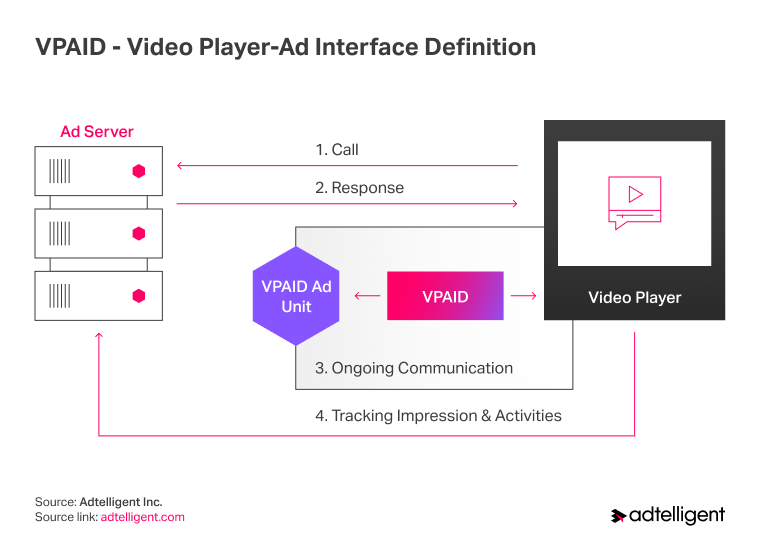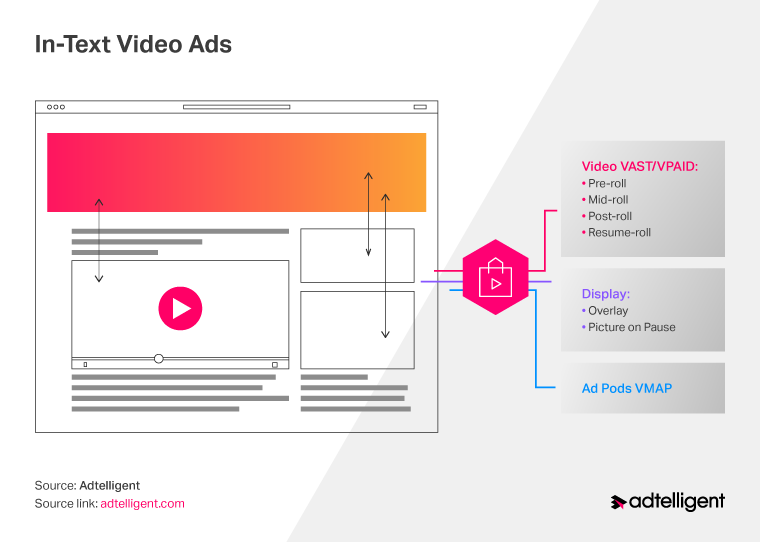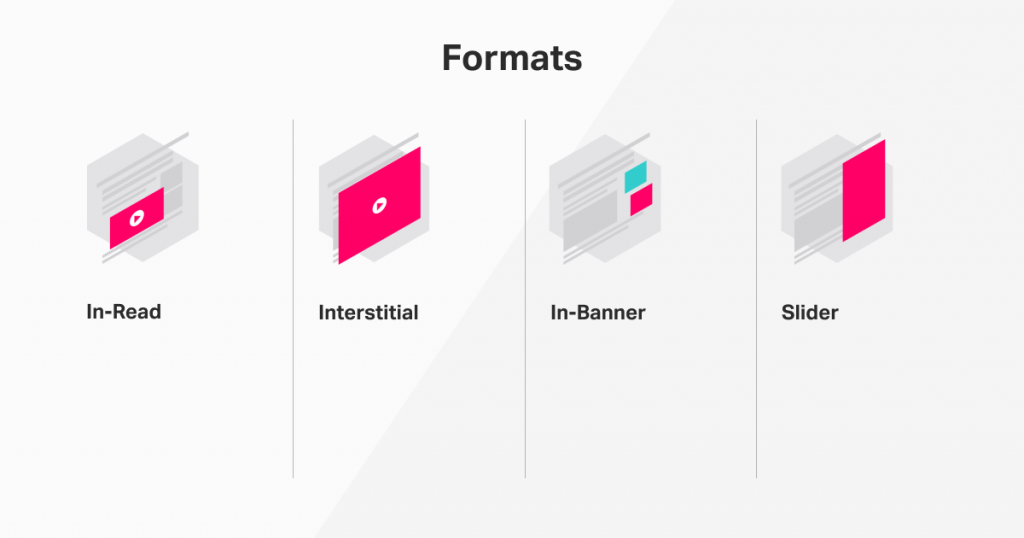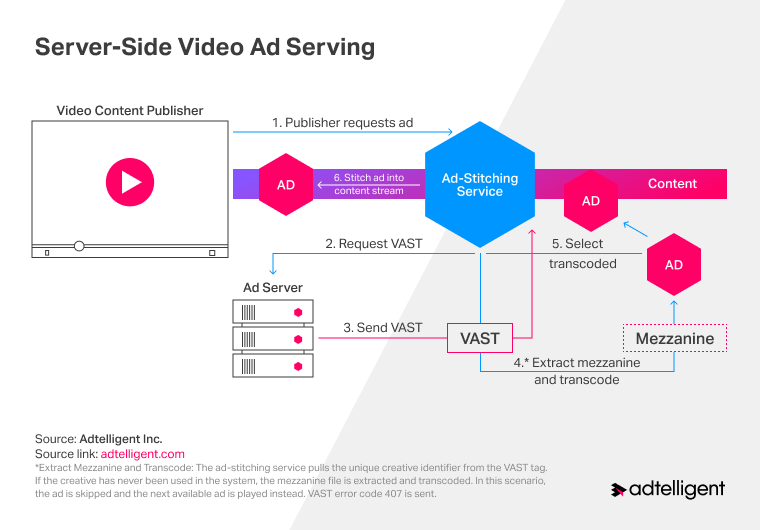What is VAST?
VAST, or “Video Ad Serving Template,” is an XML schema used by ad platforms and HTML 5 Players to serve video ads. Using VAST allows publishers to manage the video player ads and set up some specifics such as:
- What ad creative should be played;
- Whether it is possible to skip an ad and when the user can skip it;
- The timing of the advertisement in the course of the video content
- What happens after the CTA (call to action)
VAST operates on devices and environments like Desktop, Mobile and Tablet, web, and in-app.
How does VAST work?
The basic flow of the VAST tag starts with a video player sending a request to an ad server, asking to serve an ad. The ad server responds by generating VAST tags for the video files; they are in charge of multiple ad parameters, including rendering ads, choosing the type of media for an ad, its length and format, tracking and pricing information, and more.

There are usually three main elements in the VAST tag:
- Media file
- Tracking
- Format
There are also advanced options such as the type of an ad (pre-roll, overlay, and others), dimensions, and others.
Using XML language, the video player shows the advertising and activates the tracking URLs or the tracking pixels, which ensure the ability to track and measure the impression.

VAST tags can provide a seamless experience of video ad placement. Video players utilizing VAST can display third-party video ad content without help from the publisher’s ad server or ad network.
What is VPAID?
VPAID (video player ad-interface definition) is a common interface that connects video players and ad units, providing an interactive experience in advertising. Additional features like clicks on different tabs in one ad, zooming in and out, embedding a questionnaire within an ad, and playing games in the video ad are available to VPAID users. It can also gather information on how the viewers interact with an ad, providing more granular statistics to the marketers.

What is the difference between VAST and VPAID?
- VAST is a primary tag for video ad delivery. VPAID is used in addition to VAST for more features and the possibility of interactive video ad content.
- VAST connects the video player and ad server, while VPAID ensures interaction between the video player and ad units.
- VPAID interacts solely with the video player, and VAST shows video ads on the player in coordination with an ad server.
- VPAID can upload the ad before rendering the main video, but VAST won’t preload the ads.
Different types of VAST ads
VAST can be served in numerous ways, and here are some of the most popular ones:
Instream advertising
These high-quality video ads are played on top of the player’s content (like online entertainment). All content is in the viewer’s eyesight. These types of ads are accurately targeted. Advertisers usually pay higher for them.

The key point is that these ads come along with the content a user intends to watch. So, they engage users incomparably better than those outstream types. There are different types of instream ads:
- Pre-roll video ads
It is a video ad that plays before the online video content. Pre-roll ads are popular with both advertisers and publishers. Typically they last 6, 15, or 30 seconds and have high viewership rates because everyone is motivated to watch the original video they were looking for on the web.
- Mid-roll video ads
As it comes from the name, mid-roll ads appear between the parts of content users watch. This method is also reasonably practical because people want to finish watching their content. But it is also quite intrusive. In addition, too many mid-roll ads can frustrate the viewer and lower the efficiency of the ad message.
- Post-roll video ads
Showing ads in a post-roll mode comes with issues, as the viewer is not highly motivated to watch it after viewing the desired content. However, in some cases, it can perfectly fit when there are relevant promotions or they are shown among the continuous episodes of content.
Outstream advertising
Usually, these ads cost less. They are placed inside video players that don’t have any content. You may have seen them on news websites, on the sidebar parts of the pages. Outstream videos are still in demand; however, not all publishers are ready to place them as they’re pretty pushy. Adtelligent has the following formats of outstream video ads:
In-Read ad units are placed in the midst of editorial content.
Interstitial is a desktop video ad format that overlays the main web page content and goes away when the video is fully viewed or when the user closes the ad.
In-Banner is a video ad of a standard banner size that usually appears at the top of the page in the dedicated spots for video ads.
Slider ads placed at the bottom of a page reflect many users’ recently acquired touch screen habits, so they slide towards the end of the webpage and see the ad.

Ad Pods
Ad pods referred to multiple ads sequenced together and played back-to-back in a framework of a single ad break similar to traditional broadcast TV commercials. Ad pods give publishers a chance to return several ads from one ad request, and then those ads are played one after another. You can think of content ad breaks on streaming services such as Hulu with several ads going one after another, and it is a typical example of ad pods.

Ad pods offer high levels of control, allowing for competitive separation of ads that can compete. In addition, it is an excellent way to monetize longer video content. This type of ad gives advertisers more control over showing frequency or the position of the advertisement during the ad break. Overall – they are great for monetizing, bringing more reassurance to advertisers, prompting them to invest in CTV advertising, and helping improve user experience.
MRAID
MRAID or Mobile Rich Media Ad-Interface Definitions is a standard API for rich media ads that appear on mobile apps. MRAID API with HTML5 and JavaScript gives rich media an ability to establish communication between ads and apps, ensuring such functions as the ability to expand, resize, access native device features, handle device orientation, and support full-screen interstitial ads. In addition, MRAID helps brands quickly and easily build rich media shops that will run across different publishers’ apps.
History of VAST updates
Created by IAB, the first version of VAST was released in 2008. It was a unique solution that prompted the standardization of video ads.
The image below compares some of the major updates of VAST that were brought into action.

Over the years, VAST had 4 major updates. In the latest one, VAST 4.0, ad stitching was added, the feature that helps publishers to bypass the ad blocker software.

Recently, the IAB has added audio to the VAST, eliminating the need for DAAST (Digital Audio Ad Serving Template), which provides industry standards for serving audio ads, execution, and reporting across various devices and platforms. All versions of VAST from 4.1 now include this functionality. We have mentioned the differences within the latest VAST updates, which you can read here.
How to start using the VAST tag?
Creating a VAST tag is not a particularly complex task, and it usually can be done in one of the following ways:
Manually
Those publishers that are familiar with XML and pre-defined parameters can create a VAST tag without any additional difficulties. In addition, editing and mixing the parameters is an easier option for ad op developers compared to the chance of coding a completely new file.
Using Ad Server
Through an advertising servers (for instance, Adtelligent Video Ad Server); Google Ad Manager and other Ad Servers provide a more simplistic way to create a VAST tag:
- Get an account on any video ad server.
- Create a video ad unit.
- Generate VAST tag URL or VAST XML.
- Select type, specific ad options, and additional macros for the HTML5 player.
VAST Tag Generators
Using 3rd-party VAST tag generators ad operation managers can create any tag, if they do not know how to deal with XML files and want a more straightforward approach. In this case, setting the proper parameters with VAST tag generators that agree with your video player is essential to avoid any errors while showcasing the ads.
Considering the bombshell statistics that prove the effectiveness of video advertising, advertisers experienced a 200-300% increase in click-through rates (CTRs) if their emails contained a video. Moreover, recent stats show advertisers spend about $92 billion yearly on video ads worldwide. Speaking generally, VAST can significantly improve any monetization campaign by employing the following strategies:
- Unified solution for ad servers and video players
- Improve tracking of ad performance
- Reducing playback errors for displayed video ads
- Saving publishers time and money
- Making monetization efforts much attainable for publishers of all sizes